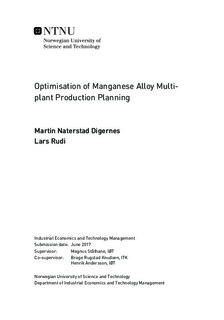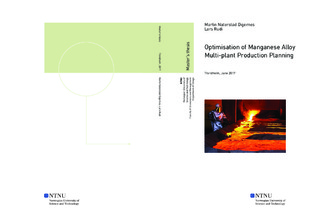| dc.description.abstract | The average concentration of manganese in the earth s crust is nearly 0.1%, making it the fourth most abundant of the metals in commercial use. Manganese alloys are mainly consumed as alloying elements in the steel industry. Manganese ores are extracted at mining sites and smelted to manganese alloys at smelting sites. In the production of manganese alloys, the problem is to find the optimal combination of ores, fluxes, coke, and slag to feed the furnaces that yields alloys that meet customer specifications and to optimally decide the volume, composition, and allocation of the produced slag between furnaces. The alloys are either sold or further refined and then sold. The authors name the problem as the manganese alloy multi-plant production problem.
Current decisions in the industry are based on experience and process knowledge and are denoted as single furnace optimisation. Single furnace optimisation is the practice of optimising the profit for each single furnace without considering the overall production. A multi-plant optimisation model can provide decision support to the industry and improve the current practice.
A pooling problem formulation is presented to solve the problem. To the authors knowledge, little work has been done on formulating the pooling problem for production of manganese alloys, and no formulations for multi-plant production exist in this industry. The formulation presented is flow and quality based and is a hybrid between the standard and the general pooling problem. The model is, however, subject to simplifying assumptions that may limit how realistic it is in its current state.
The bilinear terms in the mathematical formulation are linearised using the Multiparametric Disaggregation Technique (MDT) and the formulation is implemented in the linear solver FICO Xpress. To the authors knowledge, this is the first model that applies the MDT to solve largescale, real instances. The model is applied to test instances based on the industrial partner Eramet Norway s plant layout and solved to a global optimality within 3% using the MDT-algorithm. The computational study shows that the optimisation model presented can solve problem sizes of up to ten furnaces to a global optimality gap within 8% for the allotted run time, that the MDT scales well with the problem sizes tested, and that our model outperforms single furnace optimisation. It should be noted that the single furnace optimisation practice is based on mimicking the actual practice by using our model and not actual practice results. Comparing the model to real production data remains an objective, but the results indicate that multi-plant production planning can be of considerable value to manganese alloy production. | |

